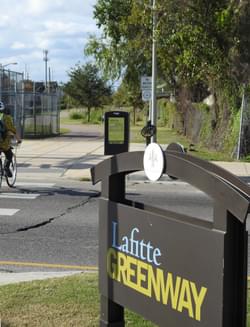




RTP funding helped convert this utility corridor into a multiuse recreational and transportation trail route.
by Stuart Macdonald, Trail Consultant, American Trails

The former shipping canal and railway that once connected the historic French Quarter to Bayou St. John has been converted into publicly accessible open space. At the heart of the Greenway is a bicycle and pedestrian trail through diverse, adjacent neighborhoods. The trail corridor has many access points which enable nonmotorized travel from residential areas to the park areas as well as to transit stops and the edge of downtown New Orleans.
The Lafitte Greenway opened in 2015. The University of New Orleans Transportation Institute counted greenway visitors as part of an effort to document and evaluate gains and trends in walking and bicycling in the city. In 12 months between July 2016 and June 2017, more than 274,000 people walked or rode a bicycle on the trail.
The trail construction project was funded by the Recreational Trails Program. The 12-foot wide paved bicycling and walking path links a variety of facilities which were funded by other sources, such as a Federal Disaster Community Development Block Grant. These recreation facilities include playgrounds, basketball courts, picnic areas, and native plant gardens. The Greenway corridor also includes ballfields, outdoor fitness parks, green space, and landscaping improvements including approximately 500 shade trees, and bioswales and stormwater retention features. The path is fully lit with LED energy-efficient trail lighting, and includes curb extensions, signalized high visibility crosswalks, curb ramps at sidewalk corners, and a crushed stone walking trail.
The City of New Orleans owns most of the 3.1-mile right-of-way. The corridor traverses
a cross-section of the city that captures its 200-year settlement pattern, from the colonial-era settlement of the Vieux Carré to the mid-20th-century suburban neighborhood of Lakeview. It has long been the objective of the City and community to convert this special right-of-way into a greenway that includes open space, recreation areas, and other amenities.
Following Hurricane Katrina, development of the Lafitte Greenway re-emerged as a City priority. The stage was set earlier, in 2007 when the New Orleans City Council passed a resolution dedicating the publicly owned land within the Lafitte Greenway Corridor “for the purpose of establishing a continuous public open space amenity or Greenway.”
Neighbor and citizens had banded together in early 2006 to form the Friends of Lafitte Greenway These New Orleans community members were concerned about post-Katrina planning, neighborhood revitalization, and open space development. According to the Friends, they were also “alarmed about short-term political decisions being made without benefit of long-term planning vision.”
Greenway founders and supporters saw an opportunity to rethink the city's landscape to enhance livability, environmental sustainability, open space equity, and health. They worked to build a network of diverse constituents who shared its vision of a greenway that “encourages active living, facilitates economic development, and links adjacent neighborhoods, cultural features, historic sites, retail areas and public spaces.”
The Friends of Lafitte Greenway hosts a wide variety of community outreach and events, including:
• “Get Fit the Green Way” series of free outdoor fitness events
• “Ready, Set, Grow!” monthly family garden classes
• The Growing the Greenway Action Committee advocates for and creates community gardens on the Lafitte Greenway
• Volunteers cleaned up over tons of litter during regular “Green-Ups”
• Partnerships with neighboring schools and organizations to educate and promote bicycle, pedestrian, and driver safety at Greenway intersections
• “Lafitte Greenway Youth Explorers” engage area schools, churches, and neighborhood groups, using nature as a classroom and playground to connect youth to the outdoors
The greenway also helps mitigate the overburdened New Orleans drainage network. According to Georgia Tech School of Civil and Environmental Engineering, “The Lafitte Greenway is setting a standard by creating a transportation link that does not generate stormwater runoff. It is designed to handle 100% of stormwater runoff it creates.”
Blackstone River Bikeway, Rhode Island
posted Apr 14, 2024
The Blackstone River Bikeway takes you through the heart of the Blackstone Valley. Peddle past historic mills, workers housing, the Blackstone Canal, the Providence and Worcester Railroad, and the Blackstone River itself.
Twenty Mule Team Trail, California
posted Mar 17, 2024
For many people, nothing symbolizes Death Valley more than the famous Twenty Mule Teams.
Hillman Heritage Trail, Kentucky
posted Mar 17, 2024
Located in Hillman Ferry Campground, portions of the trail follow a long-abandoned road that once carried old cars, wagons, and horses to the Tennessee River at Hillman Ferry.
Desert Ecology Trail, Saguaro National Park, Arizona
posted Feb 19, 2024
Located in the Sonoran desert, this paved interpretative, signed trail gives an overview of the plants, animals, and weather encountered in the desert.
1,457 views • posted 11/14/2018